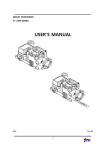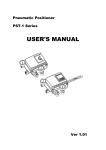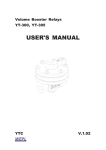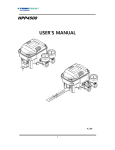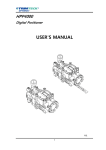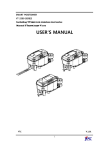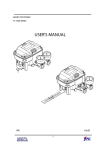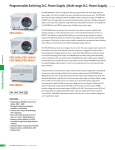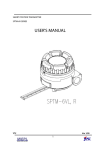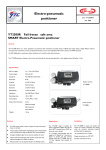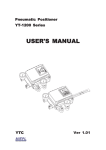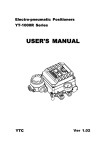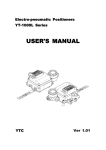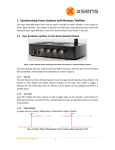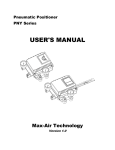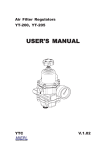Download Smart Positioner YT-2400
Transcript
SMART POSITIONER YT-2400 SERIES USER'S MANUAL YTC V.1.02 1 Table of Contents Contents Page No. Introduction 4 Manufacturer W arranty 4 Product Description 5 Main Features and Functions 5 Label Description 6 Suffix Symbol 6 Specification 7 Parts and Assembly 8 Dimensions 9 YT-2400L (Linear) 9 YT-2400R (Rotary) 10 Installation 11 Safety Warning 11 Tools for Installation 11 YT-2400L Installation 11 YT-2400R Installation 15 Bracket Information 16 Connection 19 Connection - Piping 19 Piping Connection with Actuator 20 Single Acting Actuator 20 Double Acting Actuator 20 Connection - Power 21 Connection - Terminal 22 Connection – Limit Switch 23 Connection - Ground 24 Adjustment 25 2 Adjustment - A/M Switch (Auto/Manual Switch) 25 Adjustment - Variable Orifice 25 Auto Calibration and Basic Operation 26 Button Description 26 Run Mode (RUN) 27 Auto Calibration (AUTO CAL) 28 Auto 1 Calibration 28 Auto 2 Calibration 28 Auto 3 Calibration 29 Manual Mode (MANUAL) 30 Parameter Mode (PARAM) 30 Dead-Zone (dEAZONE) 31 P-Value (KP) 31 I-Value (KI) 31 D-Value (KD) 32 Hand Calibration Mode (HANd CAL) 32 Zero-Point (PZ_ZERO) and End-Point (PZ_END) for Valves 32 Zero-Point (TR_ZERO) and End-Point (TR_END) for Transmitter 33 End-Point Ratio for Valve (PE_TRIM) 34 Normal/Reverse Feedback Signal (TR_NORM/REV) 34 Valve Mode (VALVE) 35 Acting Adjustment (ACT) 35 Characteristics Adjustment (CHAR) 35 User Characteristics (USER SET) 36 Tight Shut Open (TSHUT OP) 36 Tight Shut Close (TSHUT CL) 36 Split Range Control (SPLIT) 37 View Mode (VIEW ) 37 Error and W arning Code 38 Main Software Map 39 3 Introduction Thank you for choosing YTC product. Each product is fully inspected after the production to offer you the highest quality. In order to fully utilize the product, we strongly recommend users to read the manual carefully and fully understood. The manual should be provided to the end-user. The manual can be altered or revised without any prior notice. Any changes in product's specification, structure, and/or any components may not result immediate revised version of the manual. The manual should not be duplicated or reproduced for any purpose without any approval from Young Tech Co., Ltd, South Korea. Manufacturer Warranty For the safety, it is imperative to follow instructions in the manual. It is not manufacturer's liability for any damages which caused by users' negligence. It is not manufacturer's liability for any damages or accidents which resulted by any alteration or modification of the product and parts. If alteration or modification is necessary, please contact the manufacturer directly. Manufacturer warrants the product from the date of original retail purchase of the product for one (1) year, except as otherwise stated. Manufacturer warranty will not cover the products that the product have been subjected to abuse, accident, alteration, modification, tampering, negligence, misuse, faulty installation, lack of reasonable care, repair or service in any way that is not contemplated in the documentation for the product, or if the model or serial number has been altered, tampered with, defaced or removed; damages that occurs in shipment, due to act of God, failure due to power surge, and cosmetic damage. Improper or incorrectly performed maintenance or report voids this Limited Warranty. For detailed warranty information, please contact the corresponding local Young Tech Co., Ltd office or main office in South Korea. 4 Product Description YT-2400 Smart Valve Positioner accurately controls valve stroke, according to input signal of 4-20mA, which is being input from the controller. In addition, built-in micro-processing operator optimizes the positioner's performance and provides unique functions such as Auto calibration, PID control, Alarm, and Hart protocol. YT-2400R YT-2400L Main Features and Functions 1. LCD display enables users to monitor the status of the positioner. 2. With explosion proof grade of Exd IIB T6+H2, YT-2400 can be used in hydrogen area. YT- 2400 series also has IP66 protection grade. 3. The pilot relay valve installed outside of the positioner body, so it can be assembled or disassembled separately. 4. The positioned operates normally even if there are sudden changes in supply pressure and in high vibration environment. 5. The methods of Auto-Calibration is very simple. 6. Due to the small size of the positioner, it can be installed on a small actuator. 7. Low air consumption level and low voltage use (8.5V) yield lower operating cost and most of controllers can be used. 8. Variable orifice can minimize the hunting occurrences and optimize operating condition. 9. Various sets of information can be interchanged by HART communication between a valve and a positioner. 10. Valve system becomes more stable by outputting analog feedback signal. 11. Alarm function is available by using Limit Switch. 12. Various characteristics of valve can be adjusted – Linear, Quick Open, and Equal Percentage. 13. A/M switch can change the flow of the pressure, whether to send directly to an actuator. 14. Split range, 4-12mA or 12-20mA can be set. 15. Hand calibration function can be set Zero and Span values. 16. Air filter regulator can be attached with only one linear nipple. It does not require extra piping. 17. Epoxy polyester powder coating resists against the corrosion process. 5 Label Description Model Number: Indicates model name and any option (if any). Supply Pressure: Ambient Temperature: Indicates the range of supply pressure. Indicates ambient temperature for normal operation. Input: Weather Proof: Indicates the range of input signal. Indicates the protection grade. Explosion Proof: Ser / Date: Indicates the explosion-proof grade. Indicates unique serial number. Suffix Symbol YT-2400 series follows suffix symbols as follows. 6 Specification * Tested under ambient temperature of 20℃, absolute pressure of 760mmHg, and humidity of 65%. Please contact YTC for the more detailed specification. 7 Parts and Assembly The structure of YT-2400L is as shown <Figure1>. The only difference between YT-2400L and YT4300R is the feedback lever. <Figure 1> 8 Dimensions 9 10 Installation Safety Warning When installing a positioner, please ensure to read and follow safety instruction. All input and supply pressure to valve, actuator, and other related devices must be turned off. Use bypass valve or other equipment to avoid entire system "shut down." Make sure there is no remaining pressure in the actuator. Tools for Installation ① Hexagonal wrench ② Screw drivers (+) & (-) ③ Spanners for hexagonal-head bolts YT-2400L Installation YT-2400L should be installed on linear motion valve such as globe valve or gate valve using spring return type of diaphragm or piston actuator. Before installation, be sure to check for following installation components. ① YT-2400 main body ② Feedback lever and lever spring ③ Flange nut (bottom side of YT-2400L) ④ 4 pcs of hexagon head bolts (M8 x 1.25P) ⑤ 4 pcs of M8 plate washer (1) Proper bracket must be made in order to attach positioner on the actuator yoke. Please consider following when making a bracket. ① Feedback lever should be leveled at 50% of valve stroke. (Refer to Step 7) ② Feedback lever connection bar of actuator clamp should be installed at the positioner that the valve stroke and numbers which indicated on the feedback lever must be fitted. (Refer to Step 8) 11 (2) Attach YT-2400L to the bracket, which was made in earlier step, by using bolts. <Figure 3> Please refer to backside of the product for size of the bolts. The standard size of bolt is M8 X 1.25P, and other bolt sizes are available. Please contact YTC sales department. (3) Attach YT-2400L (with bracket) to the actuator yoke - DO NOT TIGHTEN COMPLETELY. (4) Connect YT-2400L feedback lever to the actuator clamp. The gap on the YT-2400L feedback lever is 6.5mm. The connection bar thickness should be less than 6.3mm. <Figure 4> 12 (5) Connect air filter regulator to the actuator temporarily. Set supply pressure of the regulator in order to position the actuator clamp at 50% of valve stroke. <Figure 5> (6) Insert connection bar into the YT-2400L feedback lever. The connection bar should be inserted at the 50% point on the feedback lever, which would help to reduce hysteresis. <Figure 6> (7) If connection bar does not point at 50% point, then adjust bracket or feedback link bar position. Failure to position at 50% would lower the linearity of the positioned <Figure 7> 13 (8) Check valve stroke. The stroke numbers are indicated on the feedback lever. Position connection bar at the number on the feedback lever according to the valve stroke. <Figure 8> To adjust, move the bracket or the connection bar. Note After installing YT-2400L, operate the valve from 0% to 100% stroke by using air filter regulator on the actuator. Both of 0% and 100%, the feedback lever should not touch the lever stopper, which is located on the backside of YT-2400L. <Figure 9> If the feedback lever touches the lever stopper, YT-2400L should be installed further away from the center of the yoke. <Figure 9> (9) After the proper installation, tighten all of the bolts on the bracket, the feedback lever, and the connection bar. 14 YT-2400R Installation YT-2400R should be used for rotary motion valve, that is ball valve, butterfly valve using rack and pinion, scotch yoke or complex type actuator, which its stem rotates 90 degrees. Before installation, be sure to check for following installation components. ① YT-2400R main body ② Fork lever and lever spring ③ 1 set of bracket ④ 4 pcs of hexagon head bolts (M8 x 1.25P) ⑤ 4 pcs of M8 plate washer 15 Bracket Information YT-2400R is supplied with standard bracket. The bracket can be used for Fork lever and NAMUR bracket. Please see <Figure 10, 11, & 12> for more detailed information. <Figure 10> 1) Standard actuator stem height (H) is 20, 30, or 50mm. After checking "H", assemble with the bracket as shown in <Figure 9, 10, & 11> 16 2) Attach bracketed YT-2400R to the actuator by using hexagon-headed and wrench bolts. Size of the bracket hole is 6mm. When tightening bolts use spring washer or similar for firm attachment to the actuator, so YT-2400R will not shake by vibration or any other impact. The direction of bracket is different by the operating condition, but normally, the positioner is installed as shown in <Figure 13>. 3) Set rotation pos ition of the actuator stem at zero point, "0%". For a single type of actuator, it is easy to check zero point, because the actuator stem is positioned at zero point when there is no supply pressure. If double acting actuator is used, check actuator stem's rotation direction (clockwise or counter-clockwise) by supplying pressure. 4) Install the fork lever as shown in <Figure 14> after setting actuator stem at zero point. Check the direction of the actuator stem - clockwise or counter-clockwise. Installation angle of the fork lever should be 45 degrees based on the linear shaft. For NAMUR shaft, the angle does not matter. 17 5) After setting fork lever position, lock nuts which are assembled on the bottom of the fork lever. Make sure to set upper height of the fork lever between 6-11mm, which is lower than upper bracket height. <Figure 15> 6) Attach YT-2400R to the bracket. Fix the clamping pin on the main shaft's center of YT-2400R and insert connection bar into the fork lever slot, so it can be locked to the fork lever spring. This sets the alignment of the main shaft of YT-2400R and center of the actuator stem. Bad alignment of the main shaft and the actuator stem lowers YT-2400R's durability, because too much force will be on the main shaft of YT-2400R. <Figure 16> 18 7) Tighten YT-2400R base and the bracket with hexagon-headed bolts and plate washer. It is recommended to tighten four bolts after checking YT-2400R's position. <Figure 17> Connection Connection - Piping Note To avoid entering moisture, oil, or dust into the product, please carefully make selection of supply pressure compressor. It is recommended to attach air filter regulator before supply port of YT-2400R. Supply Pressure Condition ① Dry air with at least 10℃ lower than ambient temperature. ② Avoid from dusty air. Filter can only sort 5 micron or larger. ③ Avoid any oil. ④ Comply with ANSI/ISA-57.3 1975(R1981) or ISA S7.3-1975(R1981). ⑤ Not to be used beyond the range of 1.4 - 7 kgf/㎠(140 - 700 kPA). ⑥ Set air filter regulator's supplied pressure 10% higher than actuator's spring range pressure. Pipe Connection ① Make sure inside of pipe is emptied. ② Do not use pipeline that is squeezed or has hole. ③ To maintain flow rate, use the pipeline that has more than 6mm inner diameter. (10mm outer diameter) ④ Do not use extremely long pipeline system. It may affect flow rate due to the friction inside of the pipeline. 19 Piping Connection with Actuator Single acting actuator YT-2400 series single acting type is set to use OUT1 port. OUT1 port should be connected with supply pressure port from actuator when using single acting type of spring return actuator. <Figure 18 & 19> Double acting actuator For YT-2400 series double acting type, when inputting current signal, supply pressure is out from OUT1. Please refer to <Figure 20 & 21> 20 Connection - Power Note Before connecting terminal, please make sure that power is off completely. Use ring type terminal to protect against oscillation or other impacts. YT-2400 series (except internal PTM or L/S type) must use DC 4-20mA. Minimum supply current should be 3.2mA for standard YT-2400, and minimum 3.8mA should be supplied for YT-2400 with HART communication. The power should not exceed 24mA. YT-2400 series with PTM or L/S option, separate power should be supplied to PTM. The voltage should be between DC 10~28V and not exceeding 30V. YT-2400 must be grounded. Please use twisted cable with conductor section area 1.25 ㎟ and that is suitable for 600V (complying to the conductor table of NEC Article 310.) The outer diameter of the cable should be between 6.35~10mm. Use shield wire to protect against electro-magnetic field and noise. Please do not install the cable near the equipments such as high-capacity transformer or motor which creates noise. When installing in hazardous area including explosive gas area, conduit tube or pressureproof packing union must be used. 21 Connection - Terminals 1) Open product cover by opening 4 M4 bolts. 2) Locate two entries on the right hand bottom part of YT-2400 body. <Figure 22> When connecting power, either pressure-proof packing union or conduit tube can be used. Please choose most appropriate connection type by considering the operating condition. Insert cable with terminal port. 3) Locate terminal of current input signal on the left hand bottom side of YT-2400. <Figure 23> Insert terminal bolts into the cable terminal entries and secure them with (+) and (-) terminals on the plate. Make sure to tighten terminal bolts with 1,5 fNm (15kgf/cm) torque. the polarity of the terminals. 22 Please check Connection – Limit Switch 1) Open the terminal box cover by using 3mm wrench. 2) There are two entries on the right hand bottom part of YT-2400. <Figure 24>. When connecting power, either pressure-proof packing union or conduit tube can be used. most appropriate connection type with consideration of the operating condition. Choose Insert cable into terminal port. 3) Limit switch terminals are located at the top of the terminal plate. <Figure 24> Top three terminals on the right indicate valve’s 0% position and bottom three terminals indicate valve’s 100% position. Insert terminal bolts into the cable terminal holes, and lock them with (+) and (- ) terminals on the plate. Make sure to tighten terminal bolts with 1.5 fNm (15kfg/cm) torque. Check the polarity of the terminal. 4) After connecting terminals, close the cover and lock bolts using 3mm wrench. 5) Direct Action (DA) or Reverse Action (RA) can be set by adjusting can be set by adjusting a switch on the right hand side of the terminal plate. <Figure 24> 23 Connection - Ground 1) Ground must be done before operating YT-2400. 2) Inside of terminal box, locate ground terminal plate on right hand bottom side of the terminal plate. The outer cable entry is located at outside of the terminal. resistance must be less than 100 ohms. 3) Please make sure that the <Figure 25> When using outside ground, use (+) screw driver to unscrew the ground bolts. Insert outside ground bolts and spring washer into ring type terminal of the ground cables and tighten them with bolts. 4) When using inside ground, use 3mm wrench the loose locking bolts of the terminal box cover. 5) After opening the cover, locate two entries on right hand bottom side of YT-2400. <Figure 25> When connecting power, either pressure-proof packing union or conduit tube can be used. 6) Locate two terminals on the right, either of terminals can be used. <Figure 25> Insert terminal bolts into the ring-typed terminal entries and lock them with 1.5 fNm (15kfg/cm) torque. 7) Close the cover and lock cover bolts tightly. 24 Adjustment Adjustment - A/M Switch (Auto/Manual Switch) On the bottom of the YT-2400 body, there is A/M Switch (Auto/Manual). If the switch is set as "A" (Auto), then the supply pressure will be transferred through YT-2400 operation. On the other hand, if the setting is "M" (Manual), then the pressure from the air filter regulator will directly supplied to the actuator regardless of YT-2400 operation. It is extremely important to check the pressure level when the switch is set as "M" (Manual). <Figure 26> ① Check whether the supply pressure of air filter regulator is too high. ② Turn the switch clockwise to set as "A" and turn counter-clockwise to set as "M" <Figure 26> Adjustment - Variable Orifice Hunting can be occurred when the actuator's volume is too small. In order to prevent hunting, orifice can be adjusted. By adjusting orifice, the flow rate of supply pressure to actuator can be adjusted. To adjust, use (-) driver to control the orifice. <Figure 27> 25 Auto Calibration and Basic Operation Note Following process will operate valve and actuator. Before starting Auto Calibration, please separate valve from the entire system, so Auto Calibration will not affect entire valve process. Button Description YT-2400 series has 4 buttons and enable to perform various functions. Please refer to <Figure 28> and table for further description.. 26 Run Mode (RUN) After power connection to YT-2400 series, following message will appear on LCD screen within 6 seconds. <Figure 29> "RUN" indicates that YT-2400 adjusts valve stroke with receiving signals (4~20mA) and "PV" indicates the process value. In RUN mode, the valve stroke continuously changes according to the input signal. There are six types of display message in RUN mode. <Figure 30> To change display, push <ESC> and <UP> at same time. The display will change in order indicated above. If <ESC> and <DOWN> pushed simultaneously, the order will be displayed in opposite order. By pressing <ESC>, the display will return to RUN Mode. 27 Auto Calibration (AUTO CAL) Auto Calibration (Auto Cal) automatically calibrates YT-2400 in very simple manner. Auto Cal process takes about 2~3 minutes, and the duration of the process varies upon the size of the actuator as well. There are 3 types of Auto Cal. <Figure 31> * It is recommended to calibrate the positioner under AUTO2 when setting the system initially. Auto 1 Calibration Auto 1 Calibration is mainly used when YT-2400 has not been set. The parameter which needs to be calibrated in order for valve system to operate, will be calibrated; however, KP, KI, and KD values do not change. <Figure 32> ① After connecting power, "READY 6,5,4,3,2,1" message will be appeared on LCD screen. ② Push <ENTER> button for 6 seconds at RUN mode and AUTO CAL message will be appeared. ③ Push <ENTER> and AUTO1 mode will be displayed. ④ Push <ENTER> and AUTO1 will be started. ⑤ After several minute, COMPLETE message will be appeared to indicate that AUTO1 calibration has been completed. Auto 2 Calibration Auto 2 Calibration sets all of the parameter which needs to be calibrated in order for valve system to operate. Auto 2 Calibration is recommended when YT-2400 is first installed on the valve system. <Figure 33> ① After connecting power, "READY 6,5,4,3,2,1" message will be appeared on LCD screen. ② Push <ENTER> button for 6 seconds at RUN mode and AUTO CAL message will be appeared. ③ Push <ENTER> and AUTO1 mode will be displayed. ④ Push <DOWN> and AUTO2 mode will be displayed. 28 ⑤ Push <ENTER> and AUTO2 will be started. ⑥ After several minute, COMPLETE message will be appeared to indicate that AUTO2 calibration has been completed. Auto 3 Calibration Auto 3 Calibration sets all of the parameters, but it does not change the zero and end point. It is recommended to manually set zero and end point first, then start Auto 3 Calibration. <Figure 34> ① After connecting power, "READY 6,5,4,3,2,1" message will be appeared on LCD screen. ② Push <ENTER> button for 6 seconds at RUN mode and AUTO CAL message will be appeared. ③ Push <ENTER> and AUTO1 mode will be displayed. ④ Push <DOWN> button twice, and AUTO3 mode will be displayed. ⑤ Push <ENTER> and AUTO3 will be started. ⑥ After several minute, COMPLETE message will be appeared to indicated that AUTO3 calibration has been completed. 29 Manual Mode (MANUAL) MANUAL MODE is used to move valve stem manually. During MANUAL MODE, YT-2300 moves valve strokes, not by input signal. The movement of the stroke does not affect YT-2400 saved data values, and it just moves valve strokes up/down physically. <Figure 35> Parameter Mode (PARAM) AUTO CAL optimizes most of the valve actuator controls. However, in some instances, there can be exceptions. Usually hunting or oscillation occurs when the valve actuator controls did not optimize. When this occurs, hunting or oscillation can be prevented by adjusting parameter values and DeadZone. 4 Types of Parameter and Adjustment ① Dead-Zone (dEAdZONE) ② P-value (KP) ③ I-value (KI) ④ D-value (Kd) Note When parameter values are changed, the positioner shows the status of the changes in realtime. In another words, you do not need to return to the RUN mode to observe the adjustments. However, in order to save the change, <ENTER> button must be pressed. 30 Dead-Zone (dEAdZONE) Dead-Zone indicates the percentage of error allowance. When there is high packing friction level, hunting or oscillation can be occurred. In this case, by adjusting Dead-Zone, hunting or oscillation can be prevented. <Figure 36> P-Value (KP) P-value indicates the ratio of the compensation signal based on the percentage of error allowance. As KP increases, the positioner finds the target value quickly, but it is more likely to occur hunting. On the other hand, as KP decreases, the positioner finds the target value rather slowly, but it is less likely to occur hunting. <Figure 37> I-Value (KI) I-value indicates the differential value which will be added on to the compensation signal based on the percentage of error allowance. As KI increases, oscillation can be occurred more likely, and as it decreases, the duration to find target point gets longer. <Figure 38> 31 D-Value (KD) D-value indicates the differential value which will be added on the previous compensation signal based on the percentage of error allowance. As KD increases, hunting can be occurred more likely, and as it decreases, it can result in low dynamic characteristic. <Figure 39> Hand Calibration Mode (HANd CAL) When user wants to confirm the calibration of the positioner after AUTO Calibration has been completed, user can manually calibrate the positioner as well by entering into Hand Calibration Mode. Zero-Point (PZ_ZERO) and End-Point (PZ_END) for Valves In PZ_ZERO mode, the zero point of valve can be adjusted, and in PV_END mode, the end point of the valve can be adjusted. <Figure 40> 32 Zero-Point (TR_ZERO) and End-Point (TR_END) for Transmitter In TR_ZERO mode, the zero point of transmitter can be adjusted, and in TR_END mode, the end point of the transmitter can be adjusted. These points should be adjusted when output signal is not constant, and/or the user wants to set transmitter output signal and actual stroke not equally. The connection should be done as shown in <Figure 41> and the procedure can be done as shown in <Figure 42> 33 End-Point Ratio for Valve (PE TRIM) When RA actuator is used, End-Point can be adjusted within 10% of total stroke, without adjusting valve's Zero-Point. <Figure 43> Normal/Reverse Feedback Signal (TR_NORM/REV) The feedback signal from position transmitter can be viewed as normal or as reverse. For example, actual input signal of 4mA can be viewed as output signal of 20mA. <Figure 44> 34 Valve Mode (VALVE) Acting Adjustment (ACT) The positioner can be set as D/A (Direct Action) or R/A (Reverse Action.) <Figure 45> Characteristics Adjustment (CHAR) There are 4 types of characteristics – Linear (LIN), Equal Percentage (EQ), Quick Open (QO), and User Set (USR). Following diagram, <Figure 46>, graphically shows each characteristics. 35 User Characteristics (USER SET) The characteristic curve can be made by selecting 16 points of the curve. <Figure 48> To utilize USER SET mode, please enter CHAR mode and select USR mode. Tight Shut Open (TSHUT OP) TSHUT OP allows the valve to open completely when the input signal reaches around 20mA. <Figure 49> Tight Shut Close (TSHUT CL) TSHUT CL allows the valve to close completely when the input signal reaches around 4mA. <Figure 50> 36 Split Range Control (SPLIT) The valve can be controlled by three input signal - 4~20mA, 4~12mA, or 12~20mA. <Figure 51> View Mode (VIEW) In this mode, user can set the positioner to display different information such as stroke value in percentage (%) or in values. <Figure 52> 37 Error and Warning Code YT-2400 series provides error and warning codes if there is/are problem/s. Warning Code Warning code will be displayed when the positioner has a possibility of not operating. 38 Main Software Map 39







































